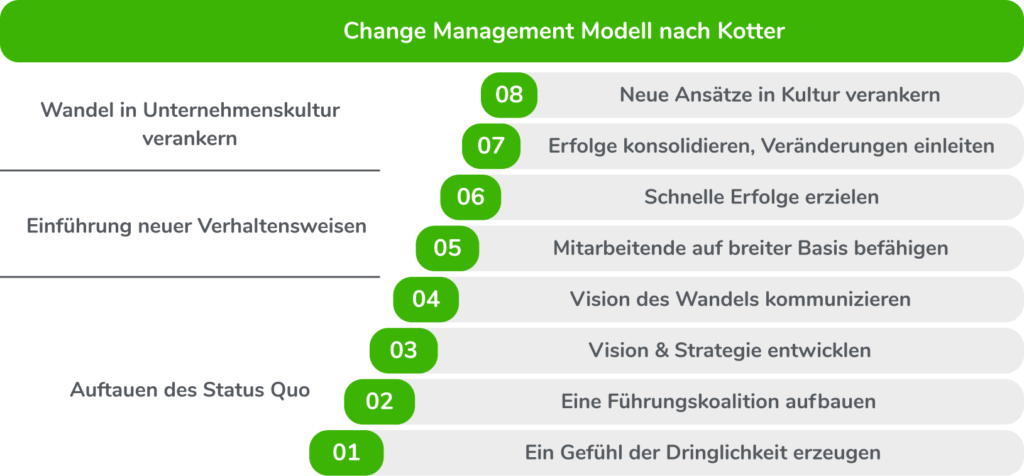Companies are currently in a complex and dynamic environment, which is also known as VUCA World referred to as. As a result, day-to-day business is increasingly shaped by changes. In this context, the Change management Developed as a permanent task and gained significantly in importance. In this article we want to introduce you to the change management model of John P. Kotter to introduce.
Change management models
Change management models can provide important assistance in accompanying a change. That is part of it 8-step model from Kotter to the classic and best-known models and serves as the basis for many other theories.
Change Management Model Kotter: Basics
The Kotters model is based on the Field theory of the psychologist Kurt Lewins and was created in 1995 on the basis of a study on successful change projects in companies.
To successfully implement a change, an organization must go through all levels of the model. The different levels are in a sequential order, but according to Kotter, an organization can be on multiple levels at the same time.
Before we go any deeper, a quick note. In two weeks we will hold a Free webinar on "Culture in agile transformation: the 5 most important success factors" - with 11 international experts as our guests! You can find more information in the teaser video below.
If that sounds interesting, check out the Project Scagile website for more information - you can also register for free.
Change management model Kotter: the eight stages
The first four stages of the change management model form the basis of the change. Levels five through seven comprise the introduction, while level eight serves to solidify the changes. The following figure shows the eight stages of the Kotter model:

1. Create a sense of urgency
According to Kotter, it is necessary to create awareness of the need for change so that employees stand behind the change and cooperate. In addition, a presentation of various scenarios makes it clear what a disregard for change would result. It also makes sense to initiate discussions with employees and managers.
Example: Imagine a restaurant with three different locations in times of the Corona crisis. As guests are no longer allowed to visit the restaurant due to the lockdown, a change is required. The management is therefore considering setting up a delivery service in order to continue generating income. In order to create a feeling of urgency, the managing director asks all employees for a meeting in which he clarifies possible scenarios that could occur without setting up the delivery service –, for example job cuts or high sales losses.
2. Build a leadership coalition
Significant changes are usually large and complex. Therefore, forming a management team is one of the essential steps in the early phases of the change. Ideally, the management team should consist of employees from different departments with different skills.
Example: The managing director sets up a management team which consists of the site managers of the three sites and the management. He ensures that all of the site managers really stand behind the matter!
3. Develop vision and strategy
Developing an effective, clear vision and a strategy for implementing it helps to create a common understanding of the direction of the change. An effective vision is always easy to communicate.
Example: To ensure that all employees have a collective understanding of the change, the management team develops a clear vision. This vision is: "From now on we will deliver our dishes with consistent quality and in strict compliance with hygiene measures to our customers from – up to and including the customer's smile". In order to realize the vision, the restaurant business needs a strategy. The strategy includes, for example, that service staff now work as suppliers.
Here, by the way, Kotter explains on his Youtube channel, how a strong vision for change can be developed:
4. Communicate the vision of change
In the next step of the change management model according to Kotter, it is important that the vision and strategy are continuously communicated so that employees accept the change and get involved. All available communication channels can be used for this. In addition, the management team should behave according to the motto "Leadership by example" and set an example of the vision and strategy.
Example: The management team wants to communicate the vision consistently and uses all available channels for this. First, they were communicated together in an online kick-off and further ideas were obtained from the employees. This also includes e-mails, the weekly team and location meetings and information posters on the bulletin board in the respective locations.
5. Empower employees on a broad basis
In the fifth stage, obstacles and disruptive structures are removed and employees are motivated to take unfamiliar, risk-taking actions and ideas.
Example: In various workshops, employees are taught how to change their work processes from now on. The aim is to put disruptive structures aside and to motivate employees to take new actions. For example, there was a workshop for the new logistics software that supports the delivery service in distributing the goods.
6. Achieve quick results
It is important to plan and implement successes or progress that can be achieved quickly. – rewards and recognizes the employees who make a significant contribution to these successes.
Example: In order to achieve quick success, a check is made after the first two days to see whether the number of dishes sold so far is less than the number of dishes sold before the lockdown. The result shows that the number has actually stayed the same and the site managers give their teams great praise!
7. Consolidate successes and initiate further changes
Successes achieved quickly can be used to initiate further change projects. Hiring people and promoting employees who exemplify the vision of change can support the change process.
Example: After the delivery service has been working perfectly so far, the management is thinking about delivering drinks as well as the dishes. As a result, after the concept has been worked out, another training session will be offered for employees in order to provide them with assistance and avoid uncertainty.
8. Anchoring new approaches in culture
In order to implement the change in the long term, according to the Kotters change management model, norms and values must be anchored in the corporate culture. It is important that new behavior and procedures as well as attitudes are continuously communicated. In addition, you should ensure that executives are setting an example of the new direction.
Example: The management team ensures that milestones that have been reached are celebrated and gives the employees the feeling that they can be proud of what they have achieved and that they have mastered the unfamiliar situation optimally. In addition, it should be considered together with the employees whether a delivery service should be integrated into the concept of the restaurant operation in the long term.
Overall, companies today have to be more and more agile in order to keep up with the uncertain and complex world. Change management can drive an agile corporate culture, what you do right here can read more.
Change Management Model Kotter: Conclusion
In summary, according to Kotter, a change always takes place in a multi-stage process. In order to prevent errors in the change process, a company must go through all the stages described above. In practice, the model is easy to use, as all stages are specifically described.
Finally, a small hint... I am repeating myself because I can really recommend it:
In two weeks there will be a Free webinar on "Culture in agile transformation: the 5 most important success factors" - with 11 international experts as our guests! You can find more information in the teaser video below.
If that sounds interesting, check out the Project Scagile website for more information - you can also register for free.
Sources – Change Management Model Kotter
- Kotter JP (1996): Leading Change, Boston: Harvard Business School Press.
- Kroehl R. (2014): Change Management. Successfully managing change initiatives, Constance: UVK Verlagsgesellschaft mbH.
- Lauer T. (2014): Change Management. Basics and success factors, 2nd edition, Wiesbaden: Springer Fachmedien.








